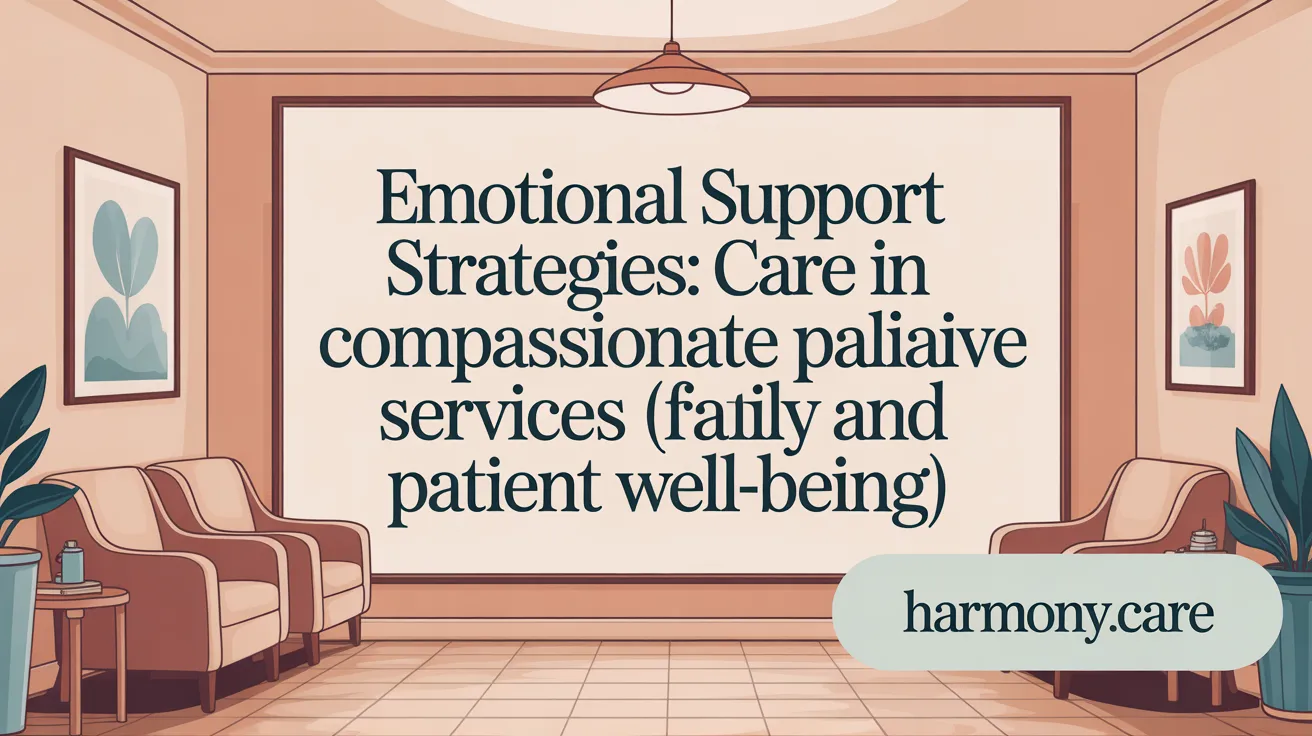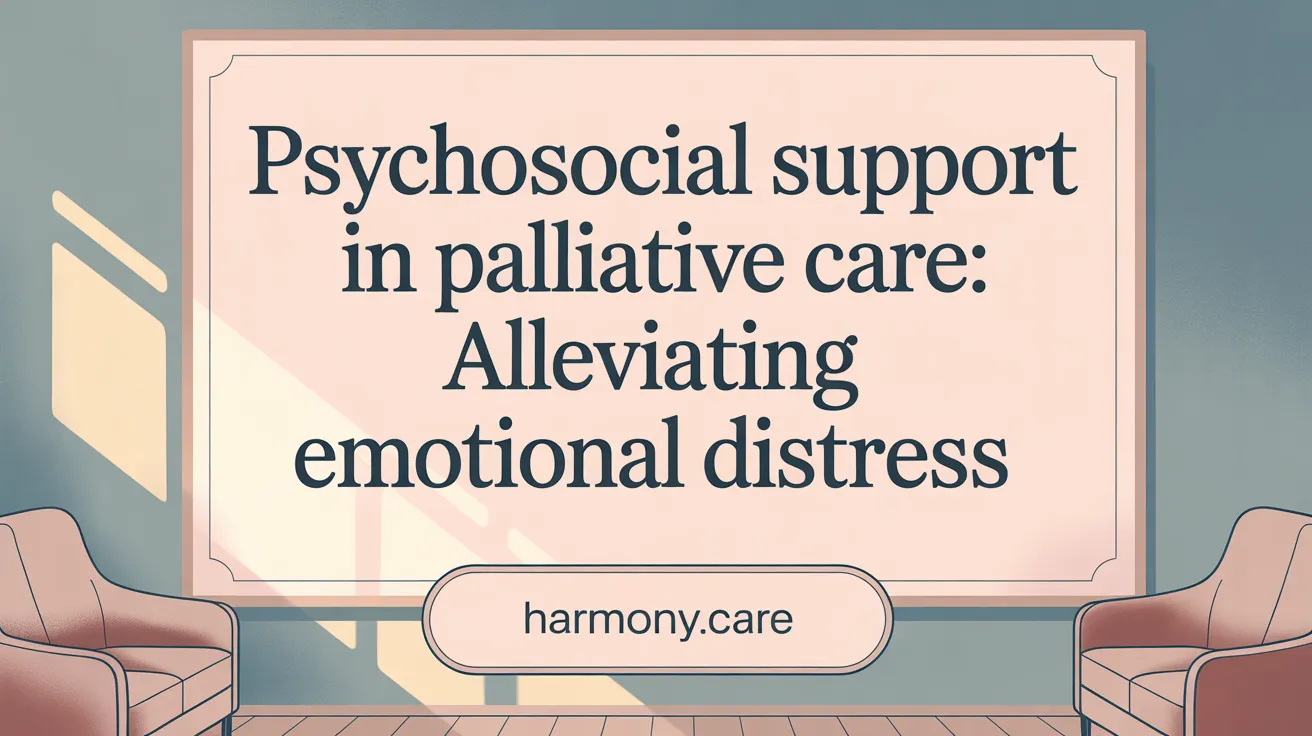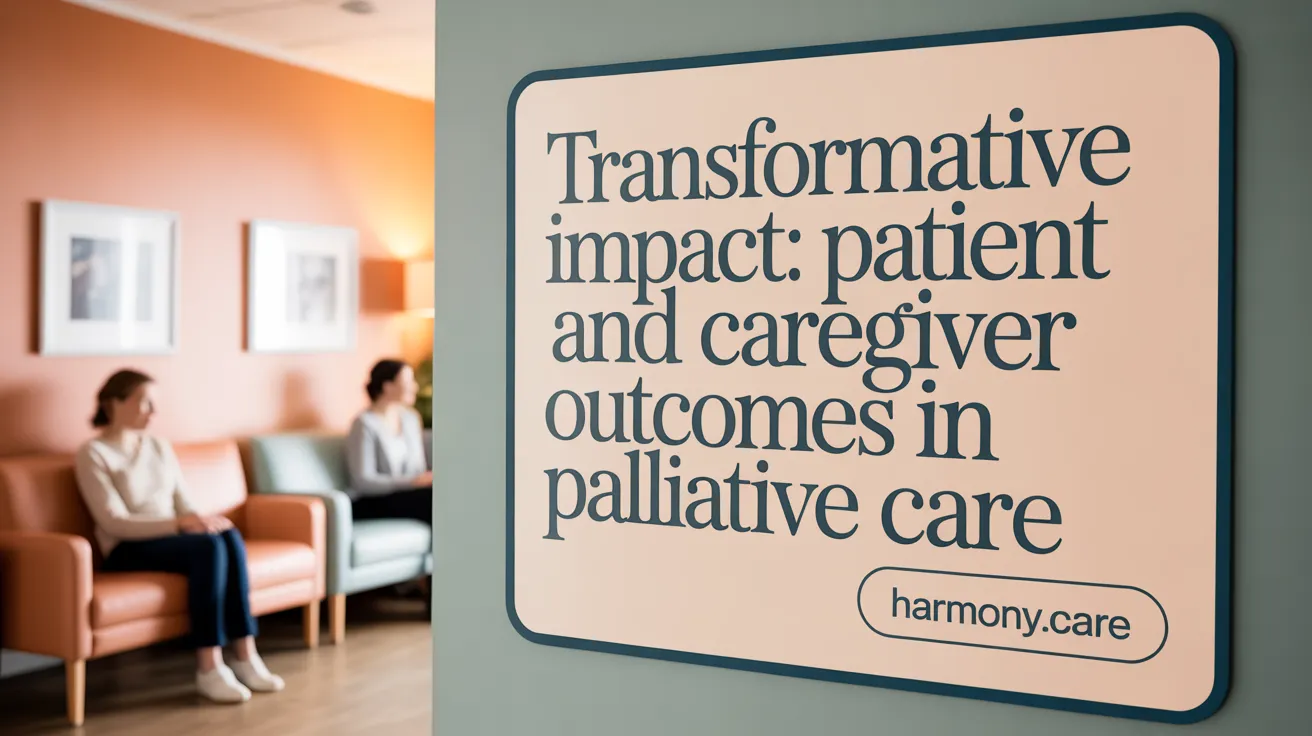Understanding Palliative Care and Its Impact on Patients' Lives
Palliative care services play a critical role in managing the complex needs of patients facing life-threatening illnesses. Focusing on both pain control and emotional support, these services aim to enhance quality of life across physical, psychological, social, and spiritual domains. This article explores the scope, benefits, challenges, and evidence supporting the effectiveness of palliative care interventions, drawing on findings from a wide body of research and clinical practice to provide a comprehensive overview for healthcare professionals, caregivers, and policy makers.
The Core Focus of Palliative Care: Managing Pain and Emotional Support

What is the general focus of palliative care services in terms of pain management and emotional support?
Palliative care primarily aims to improve the quality of life for patients with serious, chronic, or terminal illnesses by addressing both physical and emotional challenges. A central component is the management of physical symptoms such as pain, breathing difficulties, nausea, fatigue, and anxiety. Opioids are vital for controlling pain and breathlessness, and their early use is considered an ethical obligation to reduce suffering.
Alongside symptom control, palliative care offers extensive emotional, psychological, social, and spiritual support. These services help patients and their families cope with the emotional strain of illness, enhance hope, and foster better psychological well-being. The care is delivered by interdisciplinary teams—including physicians, nurses, social workers, and spiritual advisors—who work together to tailor interventions that meet each patient's unique needs.
Research indicates that early integration of palliative care not only enhances survival rates but also reduces healthcare costs and increases satisfaction among patients and families. Overall, the focus extends beyond mere symptom management to fostering holistic well-being, making palliative care a vital support system for those facing complex health challenges.
How do physical symptom management and emotional support interconnect in palliative care?
For effective palliative care, managing physical symptoms like pain and breathlessness directly influences patients' psychological and emotional state. When physical discomfort is alleviated, patients often experience reduced anxiety and depression, which in turn improves overall quality of life. Conversely, addressing emotional concerns helps patients find coping mechanisms, making it easier to tolerate physical symptoms.
Why is an interdisciplinary team essential?
The complexity of needs in palliative care necessitates a team approach. Specialized healthcare professionals collaboratively assess and address physical symptoms, emotional distress, social challenges, and spiritual concerns. This team-based approach ensures comprehensive care that adapts to changing patient conditions.
What are the benefits of early integration of palliative care?
Introducing palliative services early in the disease trajectory offers multiple benefits. Studies show that early intervention can lead to better symptom control, improved psychological well-being, and increased patient and caregiver satisfaction. Additionally, it may contribute to longer survival and fewer unnecessary hospitalizations, emphasizing its importance in holistic patient management.
Pharmacological and Non-Pharmacological Approaches to Pain Management in Palliative Care

What are common approaches used by palliative care teams to manage pain?
Palliative care teams adopt a comprehensive approach to control pain, combining medication, psychological support, and physical therapies. They typically follow a stepwise escalation based on pain severity.
For mild pain, non-opioid medications such as NSAIDs and acetaminophen are first-line choices. When pain becomes moderate, weak opioids like codeine or tramadol are introduced. Severe or breakthrough pain often requires strong opioids, notably morphine, oxycodone, or fentanyl.
Alongside opioids, adjuvant medications are frequently used. These include steroids to reduce inflammation, antidepressants for neuropathic pain, and anticonvulsants. Non-drug therapies like nerve blocks, acupuncture, physical therapy, and psychological interventions can supplement medication regimens.
Regular assessments using validated pain scales ensure treatment remains effective. Multimodal pain management tailored to individual needs aims to maximize relief and improve quality of life.
How should pain be managed according to the World Health Organization (WHO) pain ladder in palliative care?
The WHO pain ladder provides a simple framework for escalating pain management. It advocates a stepwise approach:
- Step 1: Use non-opioid medications like NSAIDs or acetaminophen for mild pain.
- Step 2: For moderate pain, introduce weak opioids—such as codeine—often paired with non-opioids.
- Step 3: Severe pain requires strong opioids like morphine or oxycodone, with careful titration.
Principles emphasize starting treatment early, dosing medications at regular intervals rather than on demand, and favoring oral administration whenever possible for comfort and compliance.
Recent perspectives suggest initiating strong opioids sooner in the pain management process, especially for progressive disease. Combining pharmacologic treatments with non-pharmacologic strategies, such as physical and psychological therapies, enhances control.
This approach helps alleviate suffering while minimizing side effects, aligning with ethical obligations to alleviate pain.
| Approach | Treatment Options | Details |
|---|---|---|
| Mild Pain | NSAIDs, Acetaminophen | First-line options, low risk of sedation |
| Moderate Pain | Weak opioids + non-opioids | Adjust doses based on response |
| Severe Pain | Strong opioids (morphine, oxycodone) | Titrated to effect, monitor for side effects |
| Adjuncts | Steroids, antidepressants | Address specific pain types |
| Non-Drug Therapies | Nerve blocks, acupuncture | Complement pharmacological management |
Emotional Support Strategies within Palliative Care

How is emotional support provided in palliative care?
Emotional support in palliative care is primarily delivered through empathetic communication and personalized psychological support techniques. Care teams emphasize active listening, allowing patients to express their fears, hopes, and feelings openly. This approach helps build trust and provides a safe space for emotional expression.
Creating a comforting environment is crucial. Teams often facilitate meaningful conversations that validate patient emotions and reassure them they are understood. Addressing psychological and spiritual needs is integral, with healthcare providers supporting spiritual practices and respecting individual coping styles.
Family and caregiver involvement also plays a significant role. Counseling and bereavement services are offered to help caregivers manage their emotional burden and prepare for the caregiving journey or eventual loss.
Interdisciplinary teams, which may include counselors, social workers, chaplains, and psychologists, enhance the holistic nature of emotional care. These specialists work together to develop tailored support plans, ensuring that physical, emotional, and spiritual aspects are comprehensively addressed.
Overall, the goal of emotional support strategies in palliative care is to reduce anxiety and depression, boost hope, and improve quality of life for patients and their families. Such interventions promote dignity, comfort, and meaningful interactions during challenging times.
Addressing Psychological and Psychosocial Concerns in Palliative Care

What are the psychological and psychosocial issues addressed in palliative care?
Palliative care aims to support patients facing serious illnesses by addressing a range of psychological and social challenges. Common issues include anxiety, depression, grief, hopelessness, fear of death, and concerns about maintaining dignity and not being a burden to others. These emotional struggles can significantly affect the overall quality of life for patients and their families.
Interventions are tailored to meet individual needs through comprehensive assessments conducted by multidisciplinary teams, including psychologists, social workers, and spiritual care providers. Psychotherapy, such as counseling and cognitive-behavioral therapy, helps patients manage emotional distress.
Meaning-centered therapies and existential support are increasingly used to help patients find purpose and acceptance, fostering emotional growth and providing a sense of closure. These approaches encourage patients to explore personal values, spirituality, and life legacy, often alleviating feelings of despair and fear.
Creating a safe and supportive environment is essential, which involves addressing mental, emotional, social, and spiritual needs. Effective communication, compassionate care, and the involvement of interdisciplinary team members ensure that patients' holistic needs are met.
Emerging digital health tools—such as telehealth, apps, and online support groups—are playing an expanding role in psychosocial support. These technologies make it easier for patients to access counseling, peer support, and educational resources from the comfort of their homes, particularly useful in remote or resource-limited settings.
Overall, by addressing these complex psychosocial concerns, palliative care helps improve psychological well-being, reduces mental health symptoms, and enhances patients' overall quality of life during challenging times.
Incorporating Spiritual Needs within Palliative Care

How are spiritual needs incorporated into palliative care?
Spiritual needs are recognized as a vital component of holistic palliative care. To address these needs, healthcare providers perform comprehensive spiritual assessments, often using validated tools like the FICA Spiritual History Tool. This allows clinicians to explore a patient’s spiritual beliefs, practices, and support systems.
Throughout the care process, compassionate presence and intentionality are paramount. Chaplains and spiritual care specialists play essential roles by offering counseling, conducting rituals, and facilitating activities like life review, which help patients find meaning and reconcile spiritual concerns.
Interventions such as mindfulness practices, prayer, and creative expressions—like art, music, or writing—are tailored to suit individual preferences and cultural backgrounds. Connecting with nature or participating in rituals can foster peace, purpose, and emotional resilience.
This holistic approach to palliative care recognizes the importance of spirituality in helping patients cope with serious illness. By integrating spiritual support into the broader care plan, providers promote emotional well-being, foster hope, and uphold the dignity of each individual during their most vulnerable moments.
Hospice Care as a Specialized Component of Palliative Services

What is the role of hospice care as a program within palliative services?
Hospice care functions as a dedicated segment of palliative services designed specifically for patients nearing the end of life, generally with an expected prognosis of six months or less. Its primary aim is to provide compassionate comfort, emphasizing quality of life rather than curative treatments.
This program involves a multidisciplinary team approach that addresses not only physical symptoms like pain and breathing difficulties but also emotional, social, and spiritual concerns. Hospice care is tailored to the patient’s desires, ensuring dignity, respect, and meaningful experiences during their final months.
Delivered in various settings such as the patient’s home, dedicated hospice facilities, nursing homes, or hospitals, hospice care offers comprehensive services. It includes medical management, psychological and spiritual counseling, and assistance for families, helping them navigate the emotional and practical challenges of end-of-life care.
How does hospice differ from general palliative care?
While both share a common goal of alleviating suffering and improving quality of life, hospice care is distinguished by its focus on the end-of-life phase for patients with limited prognosis. General palliative care can be provided at any stage of a serious illness, alongside curative treatments, and is often initiated earlier in the disease process.
In contrast, hospice services are typically initiated when curative options are no longer effective or desired, emphasizing comfort rather than disease eradication. This specific focus ensures resources and interventions are aligned with the patient’s comfort and wishes at the end of life.
What roles do care team members play?
The hospice team usually comprises physicians, nurses, social workers, spiritual advisors, and trained volunteers. Each member plays a vital role: physicians develop and oversee the care plan; nurses monitor symptoms and administer treatments; social workers provide counseling and coordinate services; spiritual advisors address spiritual needs; and volunteers offer companionship and support.
This collaborative approach ensures that physical, emotional, and spiritual needs are comprehensively met, supporting both patients and their families during this difficult time.
In which settings is hospice care typically provided?
Hospice care is flexible and delivered in settings that best meet patient needs and preferences. The most common setting is the patient’s home, supported by visiting healthcare providers. Alternatively, patients may receive care in specialized hospice facilities, nursing homes, or hospitals equipped to deliver end-of-life support.
This versatility aims to make comfort and dignity accessible, regardless of the patient’s location, ensuring personalized end-of-life experiences.
How does hospice care emphasize end-of-life quality?
The core focus of hospice is ensuring that patients experience their remaining time with as much comfort, autonomy, and emotional peace as possible. Pain and symptom management are prioritized, along with psychological, social, and spiritual support tailored to individual preferences.
By fostering open communication, providing emotional support, and respecting cultural and personal values, hospice care seeks to deliver a compassionate and respectful end-of-life journey. This approach aims to help patients face death with dignity, while supporting families through grief and bereavement processes.
Evidence Supporting the Effectiveness of Palliative Care in Pain and Emotional Outcomes

What evidence supports the effectiveness of palliative care in pain control and emotional support?
Extensive research underscores the positive impact of palliative care on pain management and emotional well-being among patients with serious illnesses. Several clinical studies have demonstrated that specialized palliative services lead to significant reductions in pain severity, particularly through the appropriate use of opioids and personalized symptom management strategies. For example, one multicenter study found that pain scores and breakthrough pain crises improved markedly within just two weeks of intervention, regardless of the care setting.
In addition to physical symptom control, palliative care greatly enhances psychological outcomes. Interventions such as group therapies, community outreach programs, and psychosocial support have been shown to improve mood, reduce depression, and foster hope among patients. Most studies report improvements in mental health indicators following these interventions, with some noting statistically significant gains in hope and overall emotional resilience.
Community-based palliative care driven by integrated primary healthcare has also contributed positively to patient outcomes. A recent study observed that patients receiving community palliative services experienced better overall physical, psychological, emotional, and social well-being. The improvement was statistically significant, with scores decreasing on measures of suffering and distress.
Educational initiatives and telehealth programs have been instrumental in expanding access to palliative support. These approaches improve patient satisfaction by providing timely, easy-to-access support for symptom management and emotional counseling, especially in resource-limited settings.
Research syntheses, including meta-analyses of multiple randomized clinical trials, consistently show that palliative care enhances quality of life by alleviating symptoms and reducing emotional distress. For instance, pooled data reveal a moderate positive effect (standardized mean difference of 0.46) on overall quality of life, with significant reductions in symptom burden (mean difference of −0.66). Although the evidence suggests no direct impact on survival rates, the substantial improvements in patient-centered outcomes make palliative care an essential component of comprehensive healthcare.
Overall, the collective evidence from clinical trials, observational studies, and systematic reviews affirms that palliative care effectively addresses both physical and emotional needs, leading to improved patient experiences and better management of suffering.
Best Practices, Standards, and Guidelines for Pain and Emotional Support in Palliative Care

What best practices, standards, and guidelines exist for implementing effective palliative care focused on pain and emotional support?
Implementing high-quality palliative care requires following established standards that prioritize patient comfort, cultural sensitivity, and individualized care. The World Health Organization (WHO) provides comprehensive pain management guidelines that advocate for early initiation of pain control measures, including the timely use of opioids like morphine for moderate to severe pain. These guidelines emphasize safe, effective use of medications, and advocate for integrated care approaches that address both physical and emotional needs.
Professional medical societies such as the American Society of Clinical Oncology (ASCO), the National Comprehensive Cancer Network (NCCN), and the European Society for Medical Oncology (ESMO) reinforce these standards. They recommend early palliative care integration, regardless of prognosis, with a focus on symptom management, psychological well-being, and strengthening patient autonomy.
A core principle across guidelines is the adoption of interdisciplinary care models. This involves collaborations among physicians, nurses, social workers, chaplains, and mental health professionals, ensuring a holistic approach to patient needs. These teams systematically assess physical symptoms and emotional distress using validated tools, enabling tailored care plans that respect cultural, spiritual, and personal preferences.
Cultural competence and ethical principles are vital in delivering respectful, equitable care. Guidelines highlight the importance of understanding cultural variations in symptom expression and treatment preferences, ensuring communication that respects patients’ beliefs and values.
Quality metrics play a critical role in maintaining care standards. Regular assessment of pain relief efficacy, psychological support, patient satisfaction, and caregiver well-being helps in continuous improvement and accountability.
Furthermore, ongoing education and training for healthcare professionals enhance their skills in managing complex pain and supporting emotional needs effectively. Encouraging team collaboration and adherence to these guidelines ensures a patient-centered environment where dignity and comfort are prioritized.
In summary, effective palliative care is built upon interdisciplinary, culturally sensitive, evidence-based protocols that promote early intervention, comprehensive assessment, and ethical practices—guided by standards from WHO and professional societies.
Impact of Palliative Care on Patient and Caregiver Experiences, Costs, and Quality

How does palliative care impact patient and caregiver experiences, costs, and quality of care?
Palliative care plays a crucial role in improving the overall experiences of both patients facing life-threatening illnesses and their caregivers. One of its primary benefits is enhanced symptom management, including pain, breathlessness, anxiety, and depression, which significantly elevates patient comfort and well-being.
Research consistently reports high satisfaction levels among patients and their families, who often value the holistic approach that addresses physical, emotional, and spiritual needs. This comprehensive support contributes to better quality of life, especially for those with advanced illnesses.
Moreover, palliative care influences where patients spend their final days. Evidence suggests that it increases the likelihood of dying at home or in preferred settings, aligning care with patient wishes.
On the healthcare utilization front, palliative interventions are associated with reductions in hospital and ICU admissions. Studies indicate a decrease in hospital stays ranging from 26% to as high as 46%, primarily due to better symptom control and care coordination. This shift not only improves patient comfort but also reduces healthcare costs significantly.
Financial analyses reveal that palliative care can lead to substantial cost savings for health systems. For instance, some programs report decreases in hospital spending of up to 59%, mainly through fewer emergency visits and inpatient stays. These savings benefit insurers and government programs by decreasing resource use.
Caregiver outcomes also improve with supportive palliative services. Caregivers report reduced stress, better understanding of disease management, and emotional support, contributing to fewer caregiver burnout cases.
While many benefits are apparent, challenges remain. Implementing palliative care broadly faces barriers such as limited access, misconceptions, and variability in service quality. Nonetheless, the overall benefits—improved patient comfort, increased system efficiency, and caregiver relief—strongly support the expansion of palliative services.
In summary, palliative care enhances the quality of care and life for patients while offering economic advantages for healthcare systems. Its focus on comprehensive support and symptom alleviation creates a better experience for patients and their families, making it an integral component of modern healthcare.
Organizational Factors Influencing Pain Management Outcomes in Palliative Care Centers

Variations in pain control across centers
Research indicates that pain management effectiveness varies significantly among different palliative care centers. These differences are influenced by organizational structures, resource availability, staff training, and adherence to pain management protocols. Some centers report substantial improvements in pain severity and breakthrough pain crises, while others achieve less optimal outcomes, highlighting disparities in service delivery.
Impact of organizational settings
Organizational environment plays a critical role in the quality of pain control and emotional support provided to patients. Factors such as interdisciplinary team composition, leadership, and care coordination influence the consistency and effectiveness of symptom management. Centers with well-integrated teams and clear communication channels tend to deliver superior pain relief and holistic care.
Data from multi-center studies
A study analyzing data from multiple palliative care centers revealed that although overall symptom control improves with standard interventions, the degree of success is closely linked to organizational factors. Centers employing comprehensive data collection tools and benchmarking practices, like the Australian Palliative Care Outcomes Collaboration (PCOC), demonstrate improved patient outcomes by facilitating continuous quality improvement.
Clinical and operational implications
Understanding how organizational factors impact pain outcomes can guide targeted interventions to enhance care quality. For example, investing in staff training, establishing standardized protocols, and fostering a culture of feedback and adaptation can reduce variability in pain management success. Policies promoting team collaboration and resource allocation are essential for achieving equitable, high-quality palliative care across different settings.
Enhancing Symptom Control Through Structured Data Collection and Feedback

How do national benchmarking initiatives contribute to improving palliative care?
National benchmarking initiatives play a crucial role in advancing palliative care by collecting and analyzing data across multiple care providers. These programs enable healthcare systems to compare performance, identify areas needing improvement, and implement targeted quality enhancement strategies. For example, the Australian Palliative Care Outcomes Collaboration (PCOC) uses national-level data to monitor patient outcomes and track progress over time.
What is the role of standardized assessment tools in palliative care?
Standardized assessment tools are essential in measuring patient symptoms, needs, and overall quality of life consistently. Instruments such as the Symptom Assessment Scale and Palliative Care Problem Severity Score provide structured ways to evaluate physical, psychological, and social dimensions of care. These tools facilitate accurate data collection, allowing clinicians to tailor interventions effectively and monitor changes over time.
How does data collection impact the quality of palliative care?
Systematic data collection and regular feedback lead to continuous quality improvement in palliative care services. When care teams receive structured reports based on standardized assessments, they can identify trends, flag emerging issues, and refine care plans accordingly. This evidence-based approach enhances symptom management, improves patient and family satisfaction, and promotes best practices across institutions.
What insights does the Australian Palliative Care Outcomes Collaboration (PCOC) case study provide?
The Australian Palliative Care Outcomes Collaboration (PCOC) exemplifies how national benchmarking and structured feedback foster improvements. By analyzing routine clinical data from over 19,000 patients, PCOC demonstrated significant progress in pain management, symptom control, and emotional support. Regular feedback mechanisms help clinicians uphold high standards of care and drive system-wide improvements, ensuring that patient-centered outcomes are prioritized.
| Aspect | Description | Outcome/Benefit |
|---|---|---|
| Benchmarking Initiatives | Collecting national clinical data for comparison | Identifies areas for improvement, guides policy development |
| Standardized Tools | Use of validated assessment instruments | Ensures consistency and accuracy in measuring outcomes |
| Feedback and Data Review | Routine analysis and reporting of clinical data | Informs continuous care quality enhancement |
| Impact on Care Quality | Improved symptom and psychological support outcomes | Enhanced patient well-being and satisfaction |
By integrating systematic data collection with benchmarking and feedback, palliative care services can significantly improve the quality of symptom management and overall patient experience.
Community-Based Palliative Care Programs: Models and Outcomes

How does community-based palliative care integrate with primary health care?
Community-based palliative care has been shown to effectively complement primary health care by providing comprehensive support that addresses physical, psychological, emotional, and social needs of patients facing life-threatening illnesses. Integrating these services into primary care settings enhances accessibility and ensures timely management of symptoms, which can lead to better overall patient outcomes.
Many programs involve interdisciplinary teams including physicians, nurses, social workers, and home health aides working collaboratively to deliver personalized care. This approach not only improves symptom control but also promotes advanced care planning and shared decision-making, making care more aligned with patient preferences.
Recent models emphasize early referral and ongoing support throughout the disease trajectory, especially for patients with uncontrolled symptoms or significant quality of life concerns. By embedding palliative services within community and primary care infrastructures, these models aim to reduce unnecessary hospitalizations and ensure holistic, patient-centered care.
What physical and psychological benefits are associated with these programs?
Evidence suggests that community-based palliative care significantly enhances physical symptom management and psychological well-being. Patients often experience better pain control, relief from breathlessness, and fewer crises related to breakthrough pain.
Psychologically, patients report reductions in mood disturbances, depression, anxiety, and hope loss. One study noted a decrease in the overall palliative care outcome score from 22.21 to 17.98 after intervention, indicating meaningful improvement across multiple well-being domains.
Furthermore, early and continuous palliative support helps patients regain a sense of control and hope, positively affecting their emotional resilience during advanced illness. These benefits extend not just to patients but also to their families, reducing caregiver burden.
What is the impact of social and emotional support?
Social and emotional support is vital for holistic palliative care. Community programs provide opportunities for patients to engage in practical and social group activities, fostering a sense of community and belonging.
Studies demonstrate that such interventions improve social connectedness and reduce feelings of isolation. Support groups, community outreach, and family counseling sessions commonly lead to heightened emotional stability and satisfaction with care.
Enhanced social support correlates with decreased psychological distress, better mood, and improved overall quality of life. These positive outcomes are often reflected in patient satisfaction surveys, where they report feeling understood, supported, and more hopeful about their remaining life.
Are there statistically significant improvements reported?
Across various studies, community-based palliative care programs consistently report statistically significant improvements in multiple outcomes. Research indicates substantial reductions in symptom severity, including pain and breathlessness, with p-values demonstrating high levels of statistical significance.
For instance, overall palliative care outcomes showed a decrease in scores signifying better physical and psychological health, with highly significant p-values (p<0.001). Similarly, patient-reported outcomes related to emotional well-being and social functioning also demonstrated meaningful improvements.
These data affirm that structured community palliative care interventions not only enhance patient quality of life but do so with measurable, statistically verified benefits.
| Aspect | Improvement Observed | Significance Level | Additional Details |
|---|---|---|---|
| Symptom management | Pain, breathlessness, nausea reduction | p<0.001 | Rigorous data collection showed marked symptom control |
| Psychological well-being | Reduced depression, anxiety, hope loss | p<0.01 | Family and patient satisfaction levels increased |
| Social support and connection | Increased engagement in community activities | p<0.001 | Fostered social connectedness and reduced isolation |
| Overall quality of life | Significant improvements in multiple domains | p<0.001 | Indicating comprehensive benefits across physical and mental health |
This evidence underscores the value of community-based palliative care programs in delivering holistic, effective support that significantly benefits patients with advanced illnesses.
Economic Evaluations and Cost Savings in Palliative Care Programs

Medicaid Palliative Care Benefit Modeling
Many health systems are exploring how to incorporate palliative care into Medicaid programs to improve care quality for seriously ill patients. Studies suggest that offering specialized palliative services can lead to substantial cost savings. The proposed model includes services like patient assessment, symptom management, advanced care planning, shared decision-making, and care coordination, delivered by a team of physicians, nurses, social workers, and home health aides. The estimated monthly cost for these services ranges from approximately $455.90 to $507.40, varying by state and specific service packages.
Cost Avoidance and Return on Investment
Implementing comprehensive palliative care for high service utilizers might produce significant financial benefits. Cost analyses indicate potential savings between $231 and $1,165 per Medicaid member per month, mainly through reductions in costly hospitalizations and emergency visits. These savings translate into a favorable return on investment, estimated at $0.80 to $2.60 for each dollar spent on palliative care. Such economic benefits not only reduce healthcare expenditures but also enhance patient and family well-being.
Reduction in Hospital Admissions
A consistent finding across multiple studies is that effective palliative care significantly decreases inpatient admissions, with reductions ranging from 26% to 46%. These decreases are primarily driven by fewer emergency department visits and hospital stays, which are often prohibitively expensive. This shift not only alleviates healthcare system burdens but also spares patients from uncomfortable and invasive hospital experiences during end-of-life care.
Challenges in Program Scalability
Despite these promising outcomes, expanding palliative care programs faces hurdles such as low referral rates, misconceptions about the scope of services, and limited awareness among providers and patients. Additionally, variations in regional Medicaid policies and reimbursement structures can impede widespread adoption. Addressing these challenges requires targeted educational efforts, policy reforms, and establishing integrated care models that embed palliative services into standard healthcare delivery.
| Aspect | Details | Implications |
|---|---|---|
| Cost of services | $455.90 - $507.40 per month | Varies by region and service package |
| Monthly savings per patient | $231 - $1,165 | Reduces hospital and emergency costs |
| Savings per dollar spent | $0.80 - $2.60 | Strong investment return |
| Hospital admission reduction | 26% - 46% | Less invasive, lower-cost care |
| Major barriers | Referrals, awareness, policies | Need for targeted strategies |
Efforts to improve integration, education, and policy support are essential to maximize the benefits of palliative care programs for both patients and healthcare systems.
Challenges and Barriers in Accessing Palliative Care Services Globally

Low coverage among those in need
Despite the enormous global need for palliative care—over 56.8 million people requiring support annually—only about 14% of these individuals currently receive the necessary services. This significant gap highlights a serious issue of limited access, especially in lower-income regions where healthcare systems are often under-resourced. Many patients with chronic illnesses like cancer, cardiovascular diseases, and respiratory conditions face obstacles in obtaining essential symptom management and emotional support.
Regulatory and policy barriers
Access to palliative care is often hindered by restrictive regulations on essential medicines, such as opioids. These medicines are crucial for managing pain and breathlessness but are frequently difficult to obtain due to complex legal frameworks and stringent controls aimed at preventing misuse. Additionally, many countries lack comprehensive national policies that integrate palliative care into their healthcare systems, impeding service development and delivery.
Training deficiencies
Another significant challenge is the limited training of healthcare professionals in palliative care principles. Without adequate education and exposure, health workers may feel unprepared to manage complex symptom control, communicate effectively about end-of-life options, or provide holistic support. This deficiency results in underutilization of available services and reduces the quality of care patients receive.
Cultural misconceptions and stigma
Cultural beliefs and misconceptions also substantially impact access. In some societies, palliative care is misunderstood as giving up on treatment or associated with death, causing patients and families to reject certain services. Stigma around illnesses like AIDS and cancer can further isolate patients from seeking help, leading to delays in referral and underuse of supportive care options.
Addressing these barriers requires concerted efforts, including policy reform, increased training initiatives, education campaigns to dispel misconceptions, and regulatory adjustments to improve access to essential medicines. Only by overcoming these challenges can equitable and effective palliative care become a global reality.
The Role of Early Referral and Continuous Palliative Care Throughout Illness Trajectories

Recommendations for early specialist involvement
Early integration of specialized palliative care teams is crucial for patients with advanced or uncontrolled symptoms, especially those diagnosed with cancer or hematologic malignancies. Referring patients at diagnosis or during disease progression ensures that symptom management, psychosocial support, and advance care planning are initiated promptly. This proactive approach can improve quality of life and help manage complex symptoms before they become severe.
Integration with active cancer treatment
Palliative care should be provided alongside ongoing cancer treatments rather than after disease progression. For patients receiving active treatments like chemotherapy or clinical trials, early referral to palliative specialists supports symptom control and emotional well-being. This concurrent approach has been shown to improve patient comfort and may even enhance the effectiveness of primary treatments.
Caregiver referral guidelines
Caregivers play a vital role in supporting patients through their illness. Oncology clinicians are encouraged to refer caregivers to palliative care teams to provide them with emotional support, education, and resources. Supporting caregivers early can reduce stress, improve their ability to assist with treatment decisions, and enhance overall family well-being.
Application in clinical trials
Patients participating in early-phase clinical trials often face unique challenges, including managing uncertain outcomes and complex symptoms. Incorporating palliative care into trial settings ensures that symptom management and quality of life are prioritized. Early palliative interventions can help address physical discomfort, psychological distress, and spiritual concerns during experimental treatments, making patient experiences more manageable and aligned with their values.
This continuous and early involvement of palliative services is supported by guidelines from organizations like the World Health Organization, which emphasizes that early palliative care enhances patient outcomes and reduces unnecessary hospitalizations. Implementing these practices across healthcare settings ensures a holistic approach, addressing physical, emotional, and social needs from diagnosis through all stages of treatment.
Quality of Life Improvements Evidenced in Meta-Analyses of Palliative Care Interventions

Do palliative care interventions improve quality of life?
Many studies and meta-analyses have examined how palliative care affects patients' overall well-being. Most evidence suggests that these interventions significantly enhance mental, emotional, and social aspects of quality of life.
How do palliative care services impact mental, emotional, and social well-being?
Patients receiving palliative care often experience notable improvements in mood, emotional stability, and social support. For instance, symptom control and psychological support help reduce feelings of distress, depression, and social isolation. Data from large reviews show statistically significant benefits across these domains, indicating that palliative care effectively addresses the psychological and social challenges faced by seriously ill patients.
What tools are used to measure quality of life?
Researchers frequently employ well-established instruments like the European Organisation for Research and Treatment of Cancer Quality of Life Questionnaire (EORTC QLQ), the SF-36 Health Survey, the McGill Quality of Life (MQOL), and the EQ-5D. These standardized tools help quantify improvements in physical health, emotional states, and social functioning, providing a reliable measure of how palliative care influences patient-centered outcomes.
Does the impact of palliative care differ by disease condition?
While most studies focus on patients with cancer or heart failure, research indicates similar positive effects across various chronic illnesses, including HIV/AIDS, respiratory diseases, and neurological disorders. However, the level of benefit may depend on individual circumstances, disease trajectory, and whether the interventions are implemented early in the illness course.
How does the quality of studies influence findings?
The strength of evidence varies depending on study design quality. Higher-quality studies tend to show more consistent and significant improvements in quality of life. Conversely, studies with methodological limitations may report mixed results or smaller effects. Overall, rigorous research underscores palliative care's role in significantly enhancing patients' mental and functional health, especially when delivered early and tailored to individual needs.
The Holistic Value of Palliative Care in Pain and Emotional Well-Being
The evidence overwhelmingly supports that palliative care substantially improves pain management and emotional support for patients with serious illnesses, enhancing quality of life and satisfaction for patients and caregivers alike. Through interdisciplinary teams employing evidence-based pharmacologic and non-pharmacologic treatments, and addressing psychological, social, and spiritual needs, palliative care addresses the complex experience of suffering at the end of life. Challenges in access and awareness persist, underscoring the importance of continued education, policy development, and integration within health systems. Ultimately, palliative care is a vital component of compassionate, patient-centered healthcare, delivering measurable benefits in symptom control, emotional resilience, and overall well-being.
References
- Effectiveness of palliative care interventions offering social support ...
- Variations in pain management outcomes among palliative care ...
- Palliative care - World Health Organization (WHO)
- Effectiveness of Palliative Care Services in Symptom Control of ...
- Association Between Palliative Care and Patient and Caregiver ...
- [PDF] Palliative Care Projects: Synthesis of Evaluation Results 2012 - CMS
- The effect of community-based palliative supportive care integrated ...
